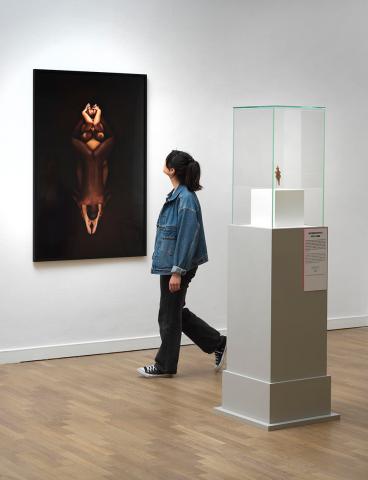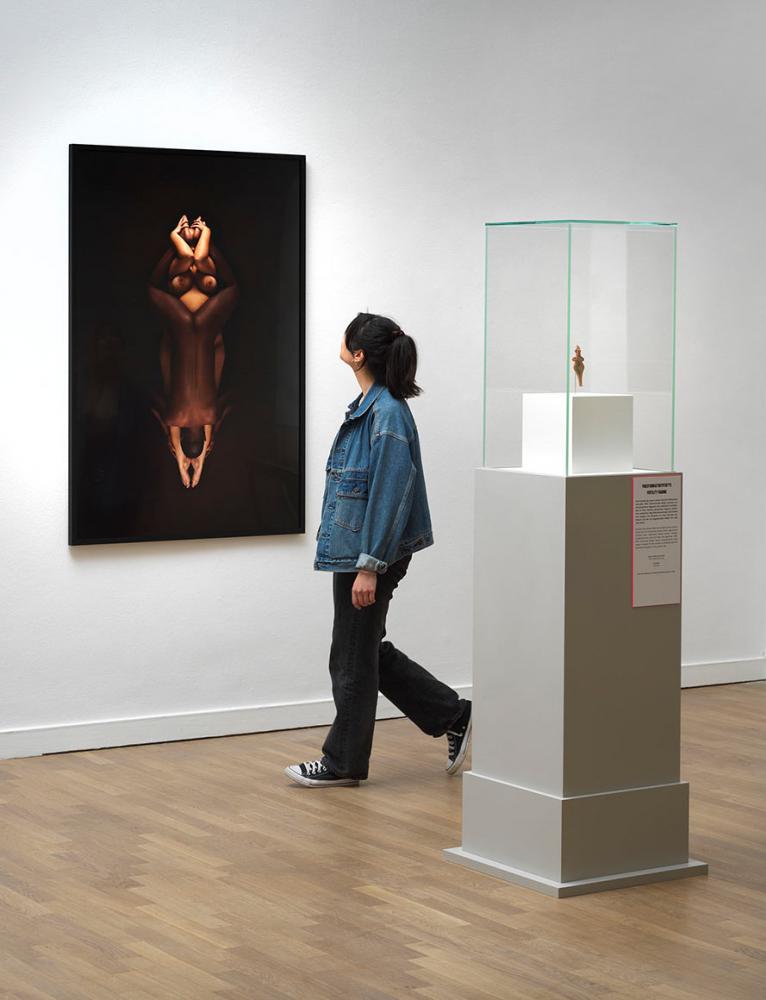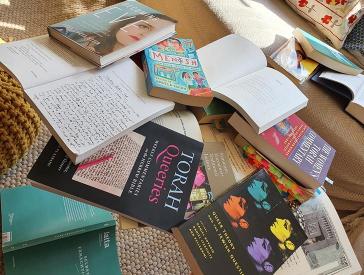
Exhibition view; Jewish Museum Berlin, photo: Jens Ziehe
The Song of Songs: Between Literal and Allegorical Loves
An Essay by Ilana Pardes
The Song of Songs opens with a craving to be kissed:
“Let him kiss me with the kisses of his mouth, /
for your loving is better than wine ... /
poured oil is your name”
(Song 1:2–3)1
The beloved craves not just kisses, but luscious kisses. The kisses she longs for hover between intoxicating wine and perfumed oil, embodying an exhilarating welter of senses—taste, touch, and smell. Sound, too, joins this sensual celebration: a repeated “sh” rustle begins with the title of the Song of Songs, shir ha-shirim, and flows onto many of the words that follow, among them neshikot, “kisses.”2
The bulk of this ancient love poem revolves around a dialogue between two young lovers: the Shulamite, as the beloved is called, and her nameless lover.3 There is something utterly refreshing in the frank celebration of love that is found in the passionate exchanges of the two. Nowhere else in the Bible are bodily parts—mouth, lips, tongue, hair, nose, eyes, breasts, thighs—set on a pedestal; nowhere else are the sensual pleasures of love relished with such joy; nowhere else is sexual desire spelled out with utmost verve. And yet sexuality is never blatant in the Song. Instead we find a nuanced combination of audacity, innocence, and decorum, made possible by a spectacular metaphoric web which allows the two lovers to be direct and indirect at once.
Both lovers are masters of metaphor. If in much of the love poetry of antiquity (and beyond) male lovers are set on stage as the agents of courting, here we find a strikingly egalitarian amorous dialogue between two virtuoso speakers, who woo each other while juggling a plethora of metaphors and similes from different realms.4 They liken each other to wine, perfumes, roses, trees, gazelles, doves, the moon, the sun, a crimson thread, gold, precious stones, locks, walls, and towers. No figure of speech seems to suffice in depicting love.
The primary enigma of the story of the Song’s reception is: why was a daringly sensual poem of love with no reference whatsoever to God or national history included in the Bible? There was apparently a rabbinic dispute regarding the canonicity of the Song. The account of this dispute, however, is sparse and does not spell out the official criteria used to determine canonicity. The one remnant of this debate is Rabbi Akiva’s (50–ca. 135 CE) memorable declaration that the “whole world is not worth the day on which the Song of Songs was given to Israel for all the Writings are holy and the Song of Songs is the Holy of Holies” (Mishnah Yadayim 3.5). In a striking rhetorical move, Rabbi Akiva, one of the founding sages of rabbinic Judaism, draws on the superlative structure of the phrase “Song of Songs” (shir ha-shirim) to turn the text whose holiness was called into question into none other than the “Holy of Holies” (kodesh kodashim).
Rabbi Akiva’s affirmation of the Song’s sanctity played a pivotal role in shaping the allegorical reading of the ancient love poem. For many centuries the predominant tendency in Jewish exegesis was to regard the Song as an allegorical poem whose primary objective was to celebrate divine love. The rabbinic commentary on Song 7:4 is exemplary:
“Your two breasts are like two fawns” This refers to Moses and Aaron. Just as a woman’s breasts are her glory and her ornament, so Moses and Aaron are the glory and the ornament of Israel. Just as a woman’s breasts are her charm, so Moses and Aaron are the charm of Israel (Song of Songs Rabba 4:5).5
To modern readers, any attempt to regard the Song as pertinent to sacred history or divine love seems astonishingly detached from its literal sense. But from the point of view of the rabbis of late antiquity, the possibility of interpreting the Song as anything but divine would have been unthinkable: why else was the Song included in Scripture if not to serve as a key to the mysteries of the human-divine bond?
A dramatic shift—one of the most dramatic exegetical shifts of all times—took place in the context of European Enlightenment with the rise of a new reading of the Song as an exquisite earthly dialogue between human lovers.6 There were various advocates of the literalist Song in eighteenth-century Germany, but Johann Gottfried Herder was undoubtedly the most fervent and famous of them. In his Lieder der Liebe (1778)—a German translation of the Song and a verse-by-verse commentary—he attacks traditional allegorical readings of the ancient love poem.7 After centuries of distorted readings, he writes, the time has come to admit the obvious:
What then is the content? What does it treat from beginning to end? ... Love, love. It is simply ... what it is and with every word suggests: a love song.8
The literal character of the poem, its original meaning, was obfuscated by Jewish and Christian exegesis and concealed by mystical allegories of divine love. “I read the book and can find in it not the tiniest sign, not the smallest hint that any other meaning is ... the purpose of the book.”9 Herder’s literalist approach is inextricably connected to an endorsement of the ancient love song as an aesthetic touchstone. He regards the Song as a superb product of the Bible’s unparalleled oriental imagination, a text whose subtle meanings are best understood in light of the culture and customs of the Orient. The first shock waves of the literalist readings of the Song made their way to the intellectual circles of Jewish Enlightenment in the late eighteenth and early nineteenth centuries. The scholar and poet Shlomo Löwisohn (1789–1821) provided the most substantive introduction to the literalist-aesthetic reading of the Song within the framework of the Jewish Enlightenment. His most renowned book The Rhetoric of Israel (1816), written in flowery biblical Hebrew, includes extensive adaptations of Herder’s commentaries on the Song. Löwisohn construes the Song as a passionate, triangular drama involving the Shulamite, the king, and the shepherd. King Solomon, who forces the Shulamite to reside in his harem, wooing her fervently, does not succeed in preventing the chaste maiden from running off to meet her rustic lover in the fields. Spurning every royal allurement, she ignores Solomon’s call for her to return to the harem—“Turn back, turn back, O Shulamite!” (Song 7:1)—and remains faithful to her humble shepherd.10
With the rise of Zionism, the Enlightenment Song was embraced with utmost enthusiasm. What made the Song a privileged text for secular Zionism was the fact that it required no de-theologizing, given the absence of God in these amorous dialogues. Zionist readers set out to remove the allegorical layers that had been piled upon the Song and to restore its original, literal grandeur. The biblical love poem appeared in different forms in early Zionist culture—from the many musical adaptations of the Song, to numerous artworks, folk dances, the Haggadot of the kibbutzim.11 The most elaborate visual interpretation of the Song in the Bezalel School of Arts and Crafts was provided by Zeev Raban (1890–1970) in an illuminated edition of the Song of Songs, published in 1922. In Raban’s illustrations of the Song, the lovers are positioned in highly sensuous scenes against the backdrop of oriental settings (both pastoral and urban) and the Shulamite oscillates between being covered, semi-bare, and bare. Raban’s oriental Shulamite is somehow innocent and voluptuous at once.
The Song continues to be a key text in Israeli culture. It continues to hold a privileged position in modern Israeli poetry—from Haviva Pedaya’s From a Sealed Ark to Yehuda Amichai’s Bible, Bible, with You, with You, and other Midrashim (1998); it continues to be (even more than before) an indispensable part of wedding ceremonies, and it still thrives in popular music. One of the most fascinating features of contemporary adaptations of the Song is the renewal of traditional piyyutim (liturgical poems), among them poems of the great medieval poets Solomon ibn Gabirol and Yehuda Halevi, where the ancient love poem is evoked both as earthly and divine. This contemporary mélange of literal and liturgical renditions of the Song is evident in the work of the vocal artist Victoria Hanna. Her adaptation of the dream sequence of the Song of Songs I Sleep and My Heart Is Awake allows the mystical and the sensual to blend in unprecedented ways.
No interpreter of the Song can remain indifferent to its wonders. The opening scene in the long story of the Song’s reception—its puzzling inclusion in the canon—is a prelude to much that lies ahead. Rabbi Akiva does not merely insist, dryly, that the Song needs to be canonized but rather endorses it with much fervor. Modern readers are no less passionate. Even those readers who have no interest whatsoever in searching for sanctity in the Song regard the poem’s exquisitely profound exploration of human love and bold celebration of the human body as absolutely vital to their lives. For all readers of the Song—whether modern or premodern—the ancient love poem offers much more than a springboard to reflect on love and sexuality. It entails an urgent invitation to sense the unformulated reaches of amorous pursuits.
Citation recommendation:
Ilana Pardes (2024), The Song of Songs: Between Literal and Allegorical Loves. An Essay by Ilana Pardes.
URL: www.jmberlin.de/en/node/10431
- Biblical citations here are from Robert Alter’s translation, The Hebrew Bible, New York: W. W. Norton, 2018. ↩︎
- The sound pattern of the “sh” rustle also includes the following words: Shelomo (Solomon), asher (which), yishakeni (let him kiss me), shemen (oil), and shimkha (your name). Note that there is a pun in Song 1:2 that highlights the fluidity of the kisses: “Let him kiss me,” yishakeni, is phonetically similar to the verb yashkeni, “let him make me drink.” ↩︎
- The meaning of the name Shulamite has been disputed. The most probable derivation is from Shalem, a shortened form of Jerusalem, though it is linked by punning with Solomon, Shelomo, and wholeness, shalem. ↩︎
- For more on the Song’s egalitarian stance, see Ilana Pardes, Countertraditions in the Bible: A Feminist Approach, Cambridge: Harvard University Press, 1992, Chapter 7. ↩︎
- Song of Songs rabbah: An Analytical Translation, trans. Jacob Neusner, Atlanta Georgia: Scholars Press, 1989, 48.↩︎
- For an extensive consideration of the twists and turns in the Song’s exegetical history, see Ilana Pardes, The Song of Songs: A Biography, Princeton: Princeton University Press, 2019.↩︎
- Johann Gottfried Herder, Lieder der Liebe: die ältesten und schönsten aus Morgenlande, Nebst vier und vierzig alten Minneliedern, 1778, printed in: Sämmtliche Werke, VIII, 485–588.↩︎
- Quoted in Samuel Moyn’s “Divine and Human Love,” 200. Moyn’s translation of Herder refers to the 1781 reprint of Lieder der Liebe.↩︎
- Ibid., 200.↩︎
- See Tova Cohen, Melitzat yeshurun li-Shlomo Levisohn: Ha-yetzira ve-yotzra [Melitzat Yeshurun by Shlomo Levisohn: The Work and its Author], Jerusalem: Bar Ilan University Press, 1988, 219.↩︎
- For an extensive consideration of the reception of the Song in the Israeli context see Ilana Pardes, Agnon’s Moonstruck Lovers: The Song of Songs in Israeli Culture, Seattle: Washington University Press, 2013.↩︎

Sex: Jewish Positions: Features & Programme
- Exhibition Webpage
- Sex: Jewish Positions: Exhibition, 17 May to 6 Oct 2024
- Publications
- Sex. Jüdische Positionen: Catalog accompanying the exhibition, German edition, 2024
- Sex: Jewish Positions: Catalog accompanying the exhibition, English edition, 2024
- Digital Content
- Letʼs Talk About Sex: Online feature accompanying the exhibition
- What do the artists say? Interview series accompanying the exhibition
- Listen to the exhibition’s soundtrack: Playlist on Spotify
- The Song of Songs. Between Literal and Allegorical Loves: Essay by Ilana Pardes
- “Sex Is A Force:” Interview with Talli Rosenbaum
- Androgynous Characters in I.B. Singer’s Literary Shtetl: Essay by Helena Lutz
- Jewish Places: Find information about Jewish sites related to the exhibition on our interactive map



 X
X

 X
X
